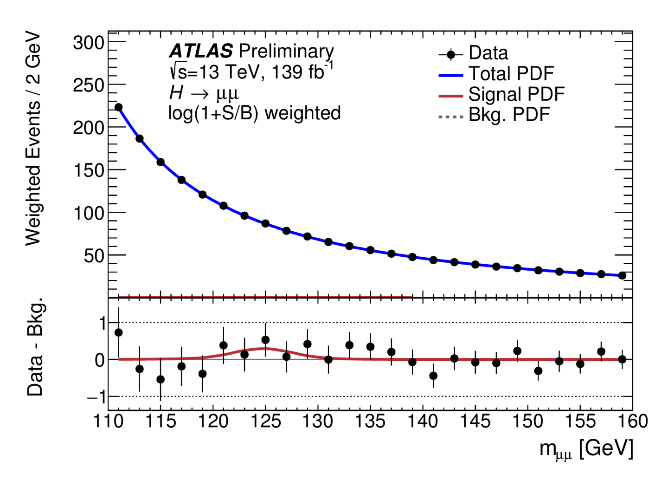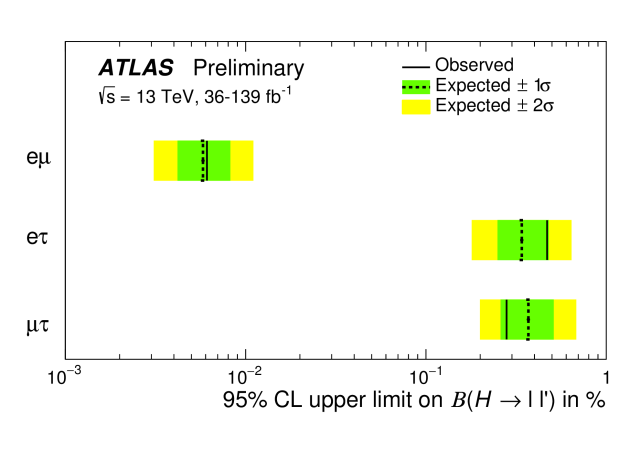Latest results from the Higgs boson couplings to second-generation fermions
The discovery of the Higgs boson completes the Standard Model, a very successful theory describing particles of visible matter and their interactions. However, there are still big missing pieces in our fundamental understanding of matter, while certain experimental phenomena point to the existence of new physics. The LHC has opened a new chapter of detailed measurements of the Higgs interactions with all other known subatomic particles. Precise measurements of the Higgs boson properties will help elucidate the nature of the Higgs and could possibly point to new physics, manifested in the form of small deviations from the theoretical predictions of the Standard Model.
Measuring the Higgs boson decay to Standard Model particles is a daunting challenge for experimentalists. Higgs boson decays to other bosons – that led to its discovery - represent only a fraction as the Higgs boson can also decay to fermions. The decay rate depends on the square of the coupling strength, which is proportional to the fermion mass. The big difference in mass between the three generations of fermions – one of the open questions for particle physics – and specifically the small masses of the first and second generation fermions as well as the large backgrounds that mimic other processes of the Standard Model make the experimental measurement of the Higgs boson decays to fermions one of the most challenging tasks. Precise measurements can provide stringent tests of the validity of the SM.
Last year, the ATLAS and CMS collaborations announced the first measurement of the Higgs boson decay to two bottom quarks (H --> bb) which accounts for about 58% of all Higgs boson decays. Moreover, both collaborations have observed the Higgs boson decaying to a τ lepton that also belongs to the third generation of fermions. These measurements were made possible thanks to the machine and detectors performance delivering a wealth of new data and to the new algorithms developed, allowing to distinguish these processes from the billions of background events. Following the measurement of Higgs boson decays to third-generation fermions, the next step is the study of the Higgs boson decays to second-generation fermions that are lighter in mass and have much lower Higgs boson decay fractions, making more complicated the identification in the detector and for the analysis. The first results of these measurements were presented during the recent EPS-HEP conference in Ghent, Belgium.
The ATLAS collaboration presented results from Higgs boson decays to a muon and antimuon pair (H-> μμ) using the full Run 2 dataset. This includes almost twice as many Higgs boson events as the previous results from ATLAS released last year for the ICHEP conference in Seoul, Korea. As muons are lighter than τ leptons the decay of a Higgs to a muon pair is predicted to occur 300 times less frequently than to tau-lepton pair. ATLAS detector’s capabilities to identify and reconstruct muon pairs, together with the good muon momentum resolution and improved signal versus background discrimination using multivariate techniques increased the sensitivity of this analysis over that of the previous year. The resulting fit is shown in Figure 1.

Figure 1. The muon pair invariant mass spectrum summed over all categories. Each event is weighted by log(1+S/B), where S and B are the number of signal and background events between 120 and 130 GeV of a given category determined by the simultaneous fit. The weighting visualizes the effect of the categorization on the analysis. The curves show the results of the fit. (Image: ATLAS Collaboration/CERN)
An upper limit on the Higgs boson production cross section times branching fraction to muons was set at 1.7 times the Standard Model prediction at 95% confidence level. This represents a 50% improvement compared to the previous measurement. No significant excess was observed, and further data will help improve the statistical limitations.
During the Lepton-Photon Symposium, the ATLAS Collaboration presented the first preliminary result for Higgs boson decays to electrons. Study of first generation fermions represent a daunting challenge for both the ATLAS and CMS experiments during the next runs of the LHC. According to the Standard Model this should be an extremely rare process, about 40,000 times less likely compared to the muon decays discussed before. Contraining this decay is important as any possible enhancement of this decay rate could reveal signs of new physics. Another difficulty in measuring this channel stems from the fact that the majority of electron-pair events originate from Z boson decays (Z→ee). The first results don’t show any excess over the background and allowed to set an upper limit on the H→ee branching ratio of 0.036% at 95% confidence level.

Figure 2. Summary of upper limits set on the branching ratio of the Higgs boson decaying into a pair of charged leptons of different flavour (lepton flavour violating decays), at the 95% confidence level. (Image: ATLAS Collaboration/CERN)
Finally, during the same conference ATLAS presented a search for Higgs-boson decays to an electron and a muon; a flavour-violating decay forbidden in the Standard Model. ATLAS set an upper limit of 0.006% of the H -> eμ branching ratio at 95% confidence level. These results pave the way for future results from both ATLAS and CMS collaborations that will scrutinise these channels with higher precision.
CMS has also recently presented their first result on searches for decays of Higgs bosons to a pair of charm quarks (H→cc). As discussed, the coupling of the Higgs boson to any SM particle is proportional to the mass of the particle itself. Charm quarks have a mass of 1.3 GeV, about 130 times lights compared to the third-generation top quark and three times less massive than bottom quarks. This means that the expected ratio of Higgs boson decays into charm quarks should be rather low compared to decays to bottom quarks and thus harder to observe. Moreover, the analysis becomes harder due to other events with similar backgrounds like the production of a Z boson in association with two additional charm quarks.
To search for the direct decay of the Higgs boson decaying to charm quarks, CMS looks for two different signatures: two separate charm quark jets, or for a unique "fat” jet of particles. Such a fat jet has a larger size and can contain both the charm and anti-charm quark from the Higgs boson.

Figure 3. Representation of a collision recorded by the CMS detector that features a Z boson decays into neutrinos and a “fat” jet consistent with two charm jets, that could be from the Higgs boson. The red and blue towers represent the energy deposits in the CMS electromagnetic and hadronic calorimeter, respectively, while the green lines represent the tracks of the charged particles as reconstructed by the CMS tracker. The yellow cones identify the jets created by charm quarks. The purple arrow indicates the missing momentum in the event carried out by undetectable particles such as neutrinos.
This distinction helps to identify all the possible scenarios accurately and maximizes the analysis sensitivity. Identifying jets formed by charm quarks and isolating them from other types of jets is a huge challenge for understanding this decay channel. Eventually, to recognize the selected jets as produced by charm quarks and discard those originated from other flavour quarks, dedicated algorithms based on advanced machine learning techniques have been deployed.

Figure 4. Upper: 95% confidence level upper limits on µ for the VH (H → cc) process from the combination of the resolved-jet and merged-jet analyses in the different channels (0L, 1L, and 2L) and combined. The inner (green) band and the outer (yellow) bands indicate the regions containing 68 and 95%, respectively, of the distribution of limits expected under the background-only hypothesis.
In the case of jets from one charm quark, a Deep Neural Network is trained to identify jets of particles that originated from charm quarks using information like the direction and energy of the jet, the information relative to the charged particle tracks inside the jet and the presence of vertices found displaced with respect to the origin of the jet of particles. The output of the charm quark identification algorithm is combined with other observables in another neural network to isolate the signal from the background. In the “fat jet” topology, instead, a novel method based on a complex Deep Neural Network architecture is trained to directly distinguish Higgs bosons decaying into a pair of charm quarks from the background processes. The double-charm neural network uses similar information but also uses the internal structure of the “fat” jet and global information on the collision to do the final signal extraction.
The results from CMS set limits on the Higgs coupling to a charm quark, improving the previous analysis sensitivity to the charm decay of Higgs bosons by a factor of four. This is a significant improvement but still away from the required sensitivity for this channel if the branching ratio is the one predicted by the Standard Model. The team expects significant further improvements in the sensitivity to the decay of the Higgs boson to charm quarks after fully exploiting the available LHC Run-2 data.
These results pave the wave for a deeper understanding of the Higgs decays to second generation fermions and both ATLAS and CMS collaborations are preparing for the larger datasets from Run 3 of the LHC and the High-Luminosity upgrade of the LHC.
